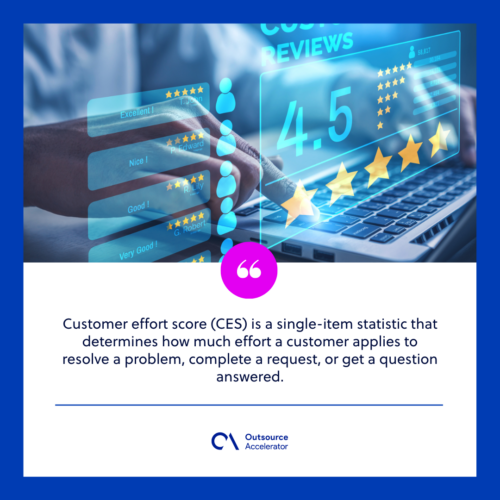Customer effort score
Definition
What is a customer effort score?
Customer effort score (CES) is a single-item statistic that determines how much effort a customer applies to resolve a problem, complete a request, or get a question answered.
Surveys measure CES by asking how easy it is to interact with a brand or company. They help gauge customer loyalty to a product or service.

What is a good customer effort score?
The basic rule of thumb is: the higher the customer effort score, the better.
There is no universal benchmark for a good customer effort score. Some companies use a 1 to 5 scale, while others use emoticons as rating responses.
A high customer effort score shows your company delivers a seamless customer experience.
Whereas a low customer effort score indicates customers find your process difficult or your customer service ineffective.
How to use customer effort score
The customer effort score identifies where your customers exert effort to address their problems or achieve an acceptable solution.
CES scores improve when consumers find it easy to do business with your company. Customers are 94% more likely to repurchase when they have an easy to low-effort experience with a brand.
Identifying roadblocks and taking measures to eliminate them will also enhance customer loyalty.
Customers whose loyalty is fading because of the excessive effort required of them can be identified by monitoring real-time customer feedback.
A customer effort score can also determine consumers who are still unsatisfied after resolving their issue. Personal contact with these consumers is the most effective way to keep them on board.
Additionally, a customer effort score is a useful tool for evaluating actual service agent performance.
Agents whose CES ratings frequently suggest more effort from the client is necessary may require more training.
Product development can also benefit from customer effort scores. Understanding customer concerns that need more work to fix could guide future product development priorities.
When to use customer effort scores?
Customer effort scores should be assessed as soon as possible. The survey is given right after a customer interaction, such as following a purchase or service call.
Customer effort score evaluation may be used in two different circumstances:
Post-purchase
Sending a customer effort score survey to a client after they’ve engaged with your company is a great way to get instant feedback on how much effort it took them to complete their purchase.
The customers just finished the purchase, so the activity and information you’re requesting is still fresh in their minds.
You may set up a survey that pops up once customers arrive on the last page confirming their purchase. Strategically insert the survey asking them about their experience.
Immediately after a service interaction
Customer effort score surveys ask consumers to evaluate the level of effort they put into addressing a problem.
Conducting surveys at regular intervals isn’t practical. Instead, businesses send them immediately after a customer interaction.
Launching the survey right after resolving a service-related experience helps evaluate how effective you are in fixing the issue.







 Independent
Independent




